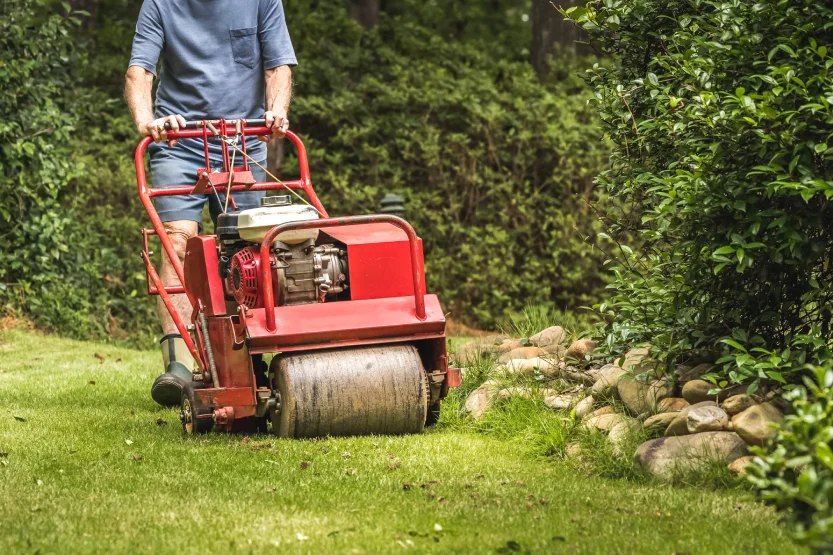Want your lawn to look fuller, greener, and more resilient next spring? The best time to make that happen is right now through proper aeration and overseeding. By loosening compacted soil and planting new seed while temperatures are still favorable, you give your lawn the best chance to bounce back strong after winter.
In Omaha and surrounding areas, late summer to early fall is usually the ideal time to aerate and overseed cool-season grasses. For warm-season lawns, late spring to early summer is best. Knowing your grass type will help you time it right.
When to Aerate and Overseed
Timing makes all the difference. For the best results, you’ll need to consider the type of grass you have.
- Cool-season grasses (like fescue, rye, or bluegrass) do best when aerated and overseeded in late summer or early fall. The soil is still warm enough for seed germination, but the cooler air helps reduce stress on the new seedlings.
- Warm-season grasses (like Bermuda or zoysia) benefit most from aeration and overseeding in late spring to early summer. That’s when these grasses are actively growing and can recover quickly.
You can also aerate in early spring, especially if your soil is heavily compacted. Be cautious when applying weed control afterward, since some herbicides can interfere with new grass growth.
How to Prepare Your Lawn
A little prep work goes a long way:
- Mow short: Cut your grass down to about 1.5 to 2 inches. This reduces competition for light and helps seeds reach the soil.
- Dethatch if needed: If your lawn has a layer of thatch more than half an inch thick, remove it so seeds can make contact with the soil.
- Water lightly: Water the day before you plan to aerate. This softens the soil, making it easier for the aerator to penetrate.
- Clear debris: Pick up sticks, rocks, and any other surface debris that might interfere with equipment or seed distribution.
Set up your tools and seed in advance so you can move smoothly from one step to the next.
Aeration: What to Do and How
Aeration opens up the soil so air, water, and nutrients can reach the roots. The most effective method is core aeration, which removes small plugs of soil and leaves holes where seed and water can settle in.
- Use a core aerator, not a spike-type. Core aerators pull plugs from the ground, while spikes can actually make compaction worse.
- Go over the lawn in multiple directions to ensure full coverage.
- Leave the soil plugs on the lawn—they’ll break down naturally and return nutrients to the soil.
Aerating right before seeding ensures the new seed lands in those freshly made holes, giving it the best chance to grow.
Overseeding Immediately After Aeration
Overseeding should follow aeration right away for maximum seed-to-soil contact.
- Choose the right seed that matches your existing lawn and suits your climate.
- Use a broadcast spreader to distribute seed evenly. For small spots, you can seed by hand.
- For full coverage, go in one direction first, then again at a perpendicular angle.
- Lightly rake the area to pull seed into holes.
- Apply a thin layer of mulch or compost if needed. This protects the seed and retains moisture.
Aftercare for Your Newly Seeded Lawn
The next few weeks are critical for success. These key recommendations will help you:
- Water often: Keep the soil consistently moist, but not soaked. Water lightly 2–3 times a day until seeds germinate. Then switch to deeper, less frequent watering.
- Avoid mowing too soon: Wait until the new grass reaches about 3 inches before mowing. Make sure your mower blades are sharp.
- Skip weed control: Herbicides can harm young grass. Hand-pull weeds until your new lawn is more established.
- Fertilize: Apply a balanced fertilizer 3–4 weeks after overseeding to encourage root growth.
Annual aeration and overseeding keep your lawn healthy and resilient long term.
How Quality Irrigation Supports Your Aeration & Overseeding Efforts
At Quality Irrigation, we know that proper watering is just as important as aeration and overseeding. Our irrigation systems help you maintain consistent moisture levels, which is essential for new grass seed to take root and thrive.
We also understand that every lawn is different. Our team can help you time and plan your lawn care based on your turf type, property conditions, and local weather. From smart sprinkler systems to expert advice on seasonal lawn prep, we’re here to make sure your lawn comes back stronger and thicker next spring.
Whether you need help designing an efficient irrigation schedule or upgrading your system to support new growth, we’re ready to assist.
Ready to Transform Your Lawn?
Start your path to a better lawn now with aeration and overseeding. With the right prep and consistent care, you’ll see greener results by the time spring rolls around. Contact us to learn more about how Quality Irrigation can support your lawn care success in Omaha and surrounding areas.
